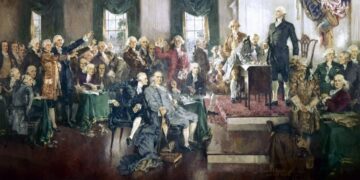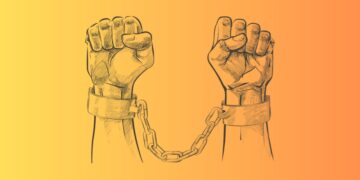Throughout history, revolutions have emerged as powerful catalysts of change, reshaping the very fabric of societies and leaving an indelible mark on the course of human civilization. Historical accounts detail a number of revolutions; organized groups of individuals who, with unwavering determination, fought ardently, often at the cost of their lives, to supplant existing ruling systems with alternative ideologies. While many of these uprisings ended in failure, scattered throughout history are instances where revolutionary endeavors culminated in triumphant success.
These transformative events transcended national borders, exerting their influence far beyond the confines of a single country and, at times, spanning entire continents. The reverberations of these upheavals have echoed through the annals of time, leaving an indelible mark on the global landscape. These revolutionary movements, marked by bloodshed and sacrifice, have played a crucial role in shaping not only the political and social fabric of their home nations but also in catalyzing profound changes on a global scale.
The following revolutions stand out as particularly noteworthy, not merely for their immediate impact but for the enduring and far-reaching consequences they have had on the course of human history. Through the crucible of conflict and upheaval, these pivotal moments have reshaped power dynamics, redefined societal structures, and sparked debates that continue to shape our understanding of progress and governance.
1. French Revolution (1789-1799)
The French Revolution, spanning from 1789 to 1799, was a watershed moment in European history, characterized by profound social, political, and economic changes. Triggered by a combination of economic hardship, social inequality, and Enlightenment ideals, the revolution aimed to dismantle the absolute monarchy and establish a more egalitarian and democratic system. The revolution began in 1789 with the convening of the Estates-General, which eventually led to the formation of the National Assembly.
This assembly, comprised mostly of representatives from the third estate (common people), declared itself the legitimate government of France. In 1789, the Bastille was stormed by Parisians, symbolizing the people’s defiance against royal authority. In 1791, the National Assembly adopted the Declaration of the Rights of Man and of the Citizen, embodying Enlightenment principles of liberty, equality, and fraternity.
The monarchy was abolished in 1792, leading to the execution of King Louis XVI. The radical phase of the revolution followed, marked by the Reign of Terror (1793-1794), led by the radical Jacobins and the Committee of Public Safety, headed by Maximilien Robespierre. The revolutionaries aimed to eliminate perceived enemies of the republic, leading to widespread executions, including that of Robespierre himself in 1794.
The revolution then entered a more moderate phase under the Directory (1795-1799), but political instability persisted. In 1799, Napoleon Bonaparte seized power in a coup, marking the end of the revolution and the beginning of the Napoleonic era. Despite the challenges and internal conflicts, the French Revolution had a lasting impact on France and Europe, contributing to the spread of democratic ideals, the rise of nationalism, and the transformation of political and social structures.
2. Russian Revolution (1917)
The Russian Revolution of 1917 was a series of revolutionary events that took place in Russia and ultimately led to the overthrow of the centuries-old Romanov monarchy, the establishment of a provisional government, and the eventual rise of the Bolsheviks to power. The revolution had profound and far-reaching consequences, shaping the course of Russian and world history. The revolution unfolded in two main phases:
- February Revolution (1917)
- This phase began with widespread discontent and food shortages among the Russian population, exacerbated by the strains of World War I. On March 8 (Julian calendar; February 23 in the Gregorian calendar), International Women’s Day demonstrations in Petrograd (modern-day St. Petersburg) escalated into mass protests against the monarchy. Soldiers, workers, and peasants joined the demonstrations, demanding an end to autocracy and better living conditions.
- Facing increasing unrest, Tsar Nicholas II abdicated the throne on March 15 (Julian calendar; March 2 in the Gregorian calendar). In the aftermath of Nicholas II’s abdication, a Provisional Government was formed, composed mainly of liberal and moderate socialist factions. However, this government faced numerous challenges, including the continuation of the war and the rise of grassroots movements like the Soviets (councils of workers and soldiers).
- October Revolution (1917)
- The Bolshevik Party, led by Vladimir Lenin, sought to capitalize on the popular dissatisfaction with the Provisional Government. On October 25-26 (Julian calendar; November 7-8 in the Gregorian calendar), Bolshevik forces seized key points in Petrograd, and the Winter Palace was stormed. The Provisional Government collapsed, and the Bolsheviks took control, marking the beginning of Soviet rule.
- The Bolsheviks, guided by Marxist-Leninist ideology, aimed to establish a socialist state based on workers’ councils (soviets). The new government signed the Treaty of Brest-Litovsk with Germany, ending Russia’s participation in World War I. However, the revolution triggered a civil war between the Red Army (Bolsheviks) and the White Army (anti-Bolshevik forces), which lasted until 1922.
The Russian Revolution ultimately led to the establishment of the Russian Soviet Federative Socialist Republic (RSFSR) and laid the foundation for the creation of the Soviet Union in 1922. It marked a radical transformation of Russian society and had a profound impact on global politics, contributing to the ideological and geopolitical landscape of the 20th century.
3. Chinese Communist Revolution (1949)
The Chinese Communist Revolution, culminating in the establishment of the People’s Republic of China in 1949, was a transformative period in Chinese history. The revolution marked the end of a long-standing struggle between the Chinese Communist Party (CCP), led by Mao Zedong, and the Nationalist government, led by Chiang Kai-shek. The roots of the conflict can be traced back to the early 20th century when China faced political instability, foreign invasions, and social upheaval.
The Chinese Communist Party, founded in 1921, sought to address issues of inequality, land reform, and foreign domination. However, internal conflicts and external threats, particularly from Japanese aggression during World War II, led to a temporary alliance between the CCP and the Nationalists against the common enemy. After the war, tensions resurfaced between the CCP and the Nationalists, resulting in the resumption of the Chinese Civil War in 1946.
The CCP, employing guerrilla warfare and winning support from peasants, gradually gained the upper hand. The decisive turning point came with the Battle of Huai-Hai in 1948, where the CCP emerged victorious, forcing the Nationalists to retreat to Taiwan. On October 1, 1949, Mao Zedong officially declared the establishment of the People’s Republic of China, signaling the end of Nationalist rule on the mainland.
The Chinese Communist Revolution brought about significant social, economic, and political changes, including land reforms, collectivization, and the establishment of a socialist system. Mao’s leadership, however, also led to controversial campaigns such as the Great Leap Forward and the Cultural Revolution, which had profound and often detrimental effects on Chinese society.
The revolution not only transformed China domestically but also had a profound impact on the global balance of power during the Cold War era. The People’s Republic of China emerged as a major player on the world stage, challenging the dominance of Western powers and aligning itself with the Soviet Union for a period before pursuing an independent foreign policy.
4. Cuban Revolution (1953-1959)
The Cuban Revolution was a transformative political and social movement that took place in Cuba from 1953 to 1959, ultimately leading to the establishment of a socialist government under Fidel Castro. The revolution was sparked by widespread discontent with the authoritarian rule of President Fulgencio Batista, who was perceived as corrupt and aligned with American interests. The revolution began in 1953 with Fidel Castro leading an unsuccessful attack on the Moncada Barracks.
Despite the failure, Castro and his followers, including Ernesto “Che” Guevara, continued their efforts to overthrow Batista through guerrilla warfare. Over the next few years, the rebels gained popular support, especially from peasants and the urban poor, as they waged a successful guerrilla campaign in the Sierra Maestra mountains. In 1959, the revolutionaries achieved victory as Batista fled the country. Fidel Castro assumed power, establishing a Marxist-Leninist government with strong ties to the Soviet Union.
The revolution brought about significant socio-economic changes, including land redistribution, nationalization of industries, and the implementation of socialist policies. It also led to tensions with the United States, as Cuba became a focal point in the Cold War. The Cuban Revolution had a profound impact on Latin American and global politics, inspiring other revolutionary movements. However, it also led to strained relations with the United States, resulting in a long-standing economic embargo. The revolution continues to shape Cuba’s political landscape and international relations to this day.
5. Glorious Revolution (1688)
The Glorious Revolution of 1688 was a pivotal event in English history that marked the overthrow of King James II and the establishment of a constitutional monarchy. The revolution was triggered by concerns among English political and religious elites about the Catholic leanings of James II and the potential threat to Protestantism and parliamentary sovereignty. In response to these concerns, a group of Protestant nobles and leaders invited William of Orange, a Dutch Protestant and James II’s son-in-law, to invade England.
William landed in England in November 1688 with a relatively small army, and James II, facing little support, fled to France. This bloodless transfer of power became known as the Glorious Revolution. Following James II’s departure, William and his wife Mary, James II’s Protestant daughter, were invited to rule jointly as monarchs. In 1689, they accepted the throne under the conditions outlined in the Bill of Rights, which granted certain rights to Parliament and the people.
This event laid the foundation for constitutional monarchy in England, limiting the powers of the monarchy and emphasizing parliamentary authority. The Glorious Revolution solidified key constitutional principles, such as the supremacy of Parliament, the rule of law, and the protection of individual liberties. It had a profound impact on shaping the political landscape of England and laid the groundwork for the development of modern constitutional government.
6. Taiping Rebellion (1850-1864)
The Taiping Rebellion was a massive and devastating civil conflict that occurred in China from 1850 to 1864. Led by Hong Xiuquan, a charismatic religious leader who believed he was the younger brother of Jesus Christ, the rebellion aimed to establish the Taiping Heavenly Kingdom, a utopian society based on radical social and religious reforms. The rebels sought to overthrow the ruling Qing Dynasty, which they perceived as corrupt and oppressive.
The Taiping Rebellion resulted in widespread chaos and bloodshed, with millions of casualties. The conflict was characterized by intense battles, siege warfare, and the imposition of strict ideological and social reforms by the Taiping forces. Foreign powers, including Britain and France, initially observed the conflict without direct involvement, but later intervened to protect their interests.
The Qing Dynasty, after facing significant challenges in suppressing the rebellion, eventually managed to defeat the Taiping forces with the assistance of regional militias and Western military advisers. The rebellion had far-reaching consequences, contributing to the weakening of the Qing Dynasty, the loss of life on an unprecedented scale, and the acceleration of social and political changes in China. The aftermath of the Taiping Rebellion set the stage for subsequent upheavals and played a crucial role in shaping the modern history of China.
7. Young Turk Revolution (1908)
The Young Turk Revolution of 1908 was a significant event in the history of the Ottoman Empire. It marked the overthrow of Sultan Abdulhamid II and the establishment of a constitutional government. The revolution was led by a group of reformist officers known as the Committee of Union and Progress (CUP), commonly referred to as the Young Turks. The Young Turks sought to address issues such as the absolute power of the Sultan, corruption, and the declining strength of the Ottoman Empire. They called for the reinstatement of the constitution of 1876, which had been suspended by Sultan Abdulhamid II.
The revolution gained momentum with widespread support from various sectors of society, including intellectuals, military officials, and civilians. In July 1908, the Young Turks forced the Sultan to restore the constitution and form a constitutional government. The Committee of Union and Progress assumed control, ushering in a period known as the Second Constitutional Era. The new government aimed to modernize the empire, improve governance, and address the diverse ethnic and religious tensions within its borders.
While the Young Turk Revolution initially inspired hope for reform, the subsequent years saw political struggles, including internal divisions within the CUP, external pressures, and World War I, which ultimately led to the disintegration of the Ottoman Empire. Despite its challenges, the Young Turk Revolution laid the groundwork for later developments in the region, such as the Turkish War of Independence and the establishment of the Republic of Turkey in 1923.
8. Haitian Revolution (1791-1804)
The Haitian Revolution (1791-1804) was a pivotal and successful uprising that led to the establishment of the independent Republic of Haiti, making it the first successful slave revolt in the Americas. The revolution unfolded in the French colony of Saint-Domingue, which was a major sugar-producing region and had a large enslaved African population. The catalyst for the revolution was the widespread discontent among the enslaved population due to harsh living conditions, brutal treatment, and aspirations for freedom and equality.
The revolution began in 1791 when a Vodou ceremony at Bois Caïman served as a rallying point for enslaved people to unite and rebel against their oppressors. Toussaint Louverture emerged as a prominent leader, demonstrating military prowess and strategic brilliance. The conflict was complex and involved various factions, including enslaved Africans, free people of color, and European powers seeking to maintain control or regain dominance.
The revolution faced numerous challenges, including intervention by France, Spain, and Britain. However, the revolutionary forces, led by Toussaint Louverture and later Jean-Jacques Dessalines, managed to overcome these obstacles. In 1804, Haiti declared its independence from France, becoming the first post-colonial independent nation in Latin America and the Caribbean.
The Haitian Revolution had profound implications, inspiring movements for freedom and equality worldwide. It also had a lasting impact on the geopolitics of the region and contributed to the decline of European colonialism in the Americas. Additionally, the revolution challenged prevailing racial hierarchies, establishing a society where former slaves played a central role in shaping the nation’s future.
9. American Revolution (1765-1783)
The American Revolution (1765-1783) was a pivotal event in world history that marked the thirteen American colonies’ quest for independence from British rule. The conflict arose from a series of grievances, including taxation without representation and perceived infringements on colonial liberties. Tensions escalated with events like the Stamp Act of 1765, the Boston Massacre in 1770, and the Boston Tea Party in 1773.
The Continental Congress convened in 1774, bringing together representatives from the colonies to address grievances and coordinate resistance. The conflict erupted into open warfare in April 1775 with the Battles of Lexington and Concord. The following year, the Second Continental Congress declared independence on July 4, 1776, drafting the Declaration of Independence, primarily written by Thomas Jefferson.
The war unfolded with notable battles such as Saratoga and Yorktown, where American forces, aided by French support, secured crucial victories. The Treaty of Paris in 1783 formally ended the hostilities, recognizing the United States as an independent nation. The Revolution had profound implications, inspiring other independence movements and shaping the principles of democracy and individual rights. The U.S. Constitution, ratified in 1788, established the foundation for the new nation’s government, solidifying the legacy of the American Revolution.
10. Iranian Revolution (1978-1979)
The Iranian Revolution, also known as the Islamic Revolution, took place between 1978 and 1979, leading to the establishment of an Islamic Republic in Iran. The revolution marked the overthrow of Mohammad Reza Shah Pahlavi, who was seen as a pro-Western autocrat, and the establishment of an Islamic government under the leadership of Ayatollah Ruhollah Khomeini. The causes of the revolution were multifaceted, encompassing economic inequality, political repression, and the perception of cultural imperialism.
Dissatisfaction with the Shah’s regime, characterized by corruption and authoritarianism, fueled widespread protests and demonstrations. The revolution gained momentum in 1978 with protests escalating across the country. The secular and leftist opposition, along with various factions, initially joined forces against the Shah. However, as the revolution progressed, Khomeini emerged as the prominent leader, advocating for an Islamic republic.
In January 1979, the Shah fled Iran, leading to Khomeini’s return from exile. A national referendum in April 1979 resulted in overwhelming support for the establishment of an Islamic Republic. Subsequently, Iran underwent a series of political and social transformations, including the adoption of Islamic law and the marginalization of secular and leftist forces. The revolution had significant regional and global implications, contributing to shifts in Middle Eastern geopolitics.
The U.S.-Iran relationship also underwent a drastic change, with the seizure of the U.S. Embassy in Tehran and the subsequent hostage crisis, which strained diplomatic ties for years. Overall, the Iranian Revolution was a pivotal event that reshaped the political landscape of Iran, establishing an Islamic government that has endured to the present day.
Takeaway
Revolutions come in all shapes and sizes, but at their core they are mass mobilizations that simultaneously overthrow both the government and the social structures that support the political system, ushering in rapid and significant change to a society. The significance of these revolutions lies not only in the dramatic shift of power and ideology but also in the enduring debates they have sparked about the nature of change, progress, and the role of the individual within the collective tapestry of society.
Whether viewed as catalysts for positive transformation or criticized for the turmoil they unleashed, these revolutions undeniably constitute crucial chapters in the story of humanity, illustrating the complex interplay of ideals, aspirations, and the inherent struggles for liberty and justice. Ultimately, the legacy of these revolutions extends beyond their immediate historical context, serving as touchstones for understanding the evolution of societies and the perpetual quest for a more equitable and just world.

































































































































































































